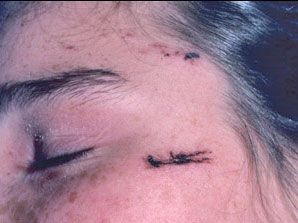Black-Spot Poison Ivy
A healthy 9-year-old girl presented with pruritic, darkly colored papules and linear lesions on the left side of her face. She had recently been on a hiking trip with her family. Examination revealed erythematous papules and linear streaks with an overlying black substance that resembled black lacquer paint.

A healthy 9-year-old girl presented with pruritic, darkly colored papules and linear lesions on the left side of her face. She had recently been on a hiking trip with her family. Examination revealed erythematous papules and linear streaks with an overlying black substance that resembled black lacquer paint. "Black-spot" poison ivy was diagnosed.
Poison ivy, or rhus dermatitis, is one of the most common causes of allergic contact dermatitis in the United States. Poison ivy belongs to the Toxicodendron genus of the Anacardiaceae family of plants, which also includes poison oak and poison sumac. The classic cutaneous reaction of multiple pruritic, erythematous papules and vesicles, often in a linear distribution, arises because of traumatic contact with urushiol, which is found in the plant's sap.
When urushiol is exposed to humid, warm conditions, it is oxidized by lactase and turns into a dark brown to black lacquer-like substance.1 High concentrations of the oxidized resin can result in black-spot poison ivy, which is both an allergic and irritant dermatitis. Black-spot poison ivy is thought to be an uncommon presentation of poison ivy because the concentrated sap is often diluted by perspiration; also, many people notice the colored resin and avoid contact with it.2
Black-spot poison ivy is treated in the same manner as common poison ivy dermatitis. After suspected exposure to poison ivy, the affected area should be immediately irrigated. Topical corticosteroids may be helpful if used early in mild cases. Treatment of extensive poison ivy often requires systemic corticosteroids, which must be continued for 2 to 3 weeks to avoid the common "rebound" phenomenon of worsening dermatitis.1
References:
REFERENCE:
1.
Bolognia JL, Jorizzo JL, Rapini RP, eds.
Dermatology
. Elsevier; 2008:255-256.
2.
Kurlan JG, Lucky AW. Black spot poison ivy: a report of 5 cases and a review of the literature.
J Am Acad Dermatol
. 2001;45:246-249.
Recognize & Refer: Hemangiomas in pediatrics
July 17th 2019Contemporary Pediatrics sits down exclusively with Sheila Fallon Friedlander, MD, a professor dermatology and pediatrics, to discuss the one key condition for which she believes community pediatricians should be especially aware-hemangiomas.